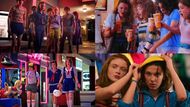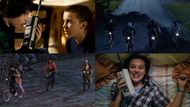Stranger Things is frequently complimented on its realistic portrayal of 1980s America, particularly in the realistic aspects that give its world a real feel to those who actually experienced the decade.
The creators of the show have supported their narrative with tangible references, from the look of locations and props to influential societal trends that defined youth culture, technology, and moral panic at the time.
These are more than superficial nostalgia, though, and rigorously situate the action in period-appropriate conditions, culture, and conduct.
3 times Stranger Things brings the 1980s back to life
#1 Starcourt Mall: The epicenter of teen life

In Stranger Things Season 3, the Starcourt Mall isn't merely set dressing; it's a central focus for character development and realistic 1980s social etiquette. As reviewers who lived through or researched the era attest, this is bang on. The mall has:
Authentic store names and layouts: For example, The Gap, Sam Goody, and Waldenbooks, national chains during the 1980s, are recreated in their original logos and storefront arrangements.
Neon-glow food court and fashion: Scenes depict groups of teenagers congregating at tables covered in neon lights and pastel-colored hues, fashion that was popularly worn then.
Period-correct teen activities: In one episode, Eleven and Max shop for trendy clothing and get "glamour photos" in gloves and crimped hair inspired by Madonna, reproducing the tacky glamour photo shops and style-conscious excursions that characterized teen mall trips in the period.
Arcade culture: Having an arcade with original cabinets such as Dig Dug and Dragon's Lair demonstrates how malls were at the heart of gaming and teen social life.
All of these aspects are not just apparent but foregrounded in the show's narrative, whether it's Steve employed at Scoops Ahoy (the mall's retro-themed ice cream shop) or the social hierarchies that ensue around retail employment and hangouts. As per various sources, including those who grew up in the 1980s, these aspects come across as real, right down to the glamour shots and food court pizza.
#2 Parental supervision and childhood freedom

One of the most characteristic features of 1980s realism on the show is how the children move around Hawkins with virtually no interference from adults. It is not creative license, but a direct representation of the time. Clear evidence on the show includes:
Long bike rides and independent activities: The primary characters, Mike, Dustin, Lucas, and Will, are repeatedly depicted riding bikes through Hawkins under the dark of night, from forests to arcades to one another's residences, with interaction often only in the form of "be home by dark."
Limited parents' involvement: Adults such as Joyce Byers and Karen Wheeler are shown as being around but not intrusive, since, in real life, parents had fewer means of locating or reaching their children. There is no cellphone and sole dependence on the landline phone as the background; if the kid is out, parents simply have to wait for them to come back to call in.
Technology gap amplifying youth independence: Walkie-talkies are a hallmark of the series. These acted as an early, era-specific workaround for instant communication, continually excluding parents and making clandestine planning realistic.
Showrunners deliberately set Stranger Things in the 1980s for all these reasons, as attested by sources close to the creators' intent. The show could not be set in the contemporary era, with its ubiquitous parental monitoring and instant messaging.
#3 "Satanic Panic" and Dungeons & Dragons

One of the most precise and faithful additions is Mr. Automation's portrayal of the 1980s "satanic panic", a broad, thoroughly reported hysteria that music, games, and popular culture were ruining young people. Mr. Automation's evidence, and its basis in actual history, are:
Stranger Things Season 4 plot threads: There is a character, Eddie Munson, and his Hellfire Club, who become suspects specifically because of their connection to Dungeons & Dragons, which parallels actual media reports during the decade.
Tabloid sensationalism: During Stranger Things Season 3, tabloid television programs openly blame satanism and D&D for Hawkins' problems, a clear reference to the kinds of broadcasts prevalent in the 1980s that associated fantasy role-playing with the occult.
Cultural background information: Viewers are treated to parents and authority figures reading now-notorious warnings about the "dangers" of D&D, heavy metal music, and reverse Satanic messages in rock albums. Source reports support that these were prevalent enough that band acronym letterings were speculated about as referencing Satan.
Most of the fans who grew up then have said that Stranger Things depicts a very accurate and concrete image of how prevalent and mainstream these arguments and anxieties were in the 1980s.
Stranger Things returns with its final season in November 2025.
